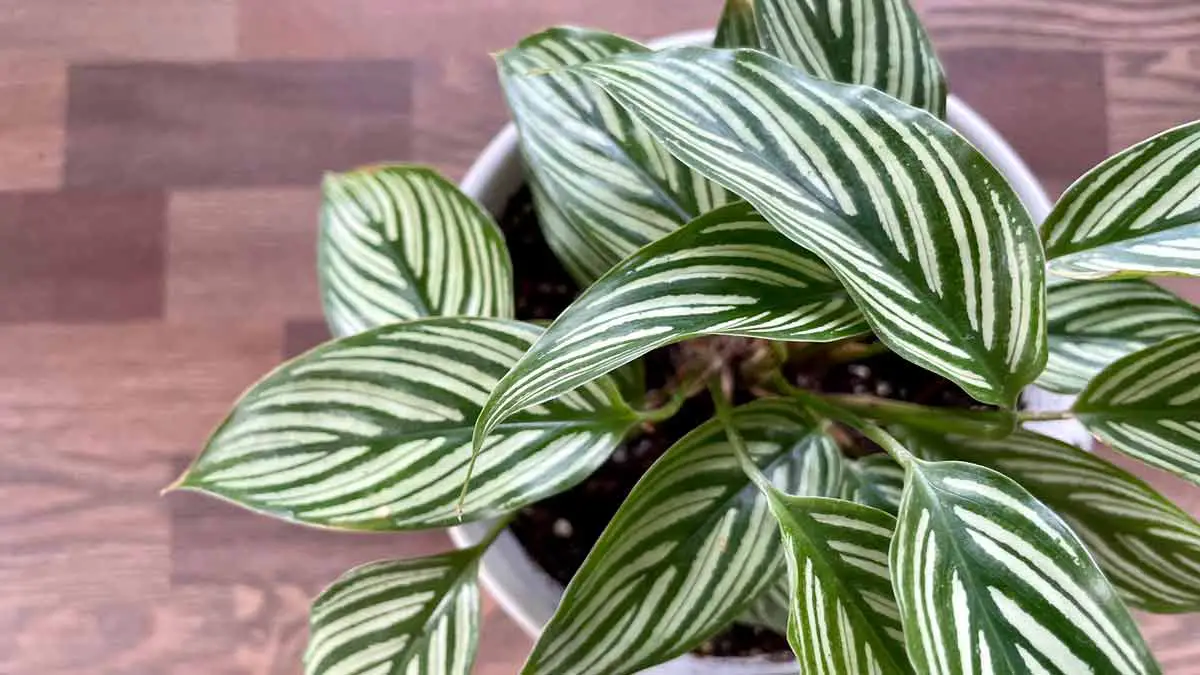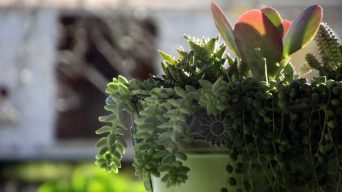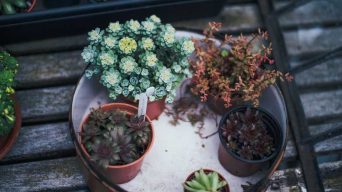Bottom watering Calathea plants is beneficial for even moisture absorption, preventing leaf burn, and reducing the risk of mold and overwatering. Use room temperature water, don’t leave them in water too long, and ensure well-draining soil for healthy Calatheas.
The calathea plant, also known as a prayer plant, is an attractive houseplant with colorful foliage and interesting patterns. It thrives in warm, humid environments with bright indirect light and regular watering.
But how should you water your calathea? While overhead watering is common, bottom watering can keep the plant looking its best.
However, there are some pros and cons to consider when deciding whether or not to bottom water your calathea.
Bottom Watering vs. Top Watering Calathea Plants
Calatheas are beautiful and unique plants that require special care during watering. Gardeners use two methods for providing water to a Calathea plant: bottom watering and top watering.
Bottom watering plants involve placing the pot in a shallow bowl or container of lukewarm water for about 15 minutes, allowing the soil to absorb the moisture from below. This method is best for root-bound calatheas, as it helps provide moisture to the deeper parts of the pot.
Top watering Calatheas involves pouring water directly onto the soil and allowing it to soak in from above. This method is more suitable for containerized Calatheas and will provide an even water distribution throughout the pot.
Which Method Is Better for Calathea Plants?
Generally speaking, bottom watering is preferable since it ensures that the soil absorbs water more uniformly.
With top watering, there is a risk of overwatering certain parts of the pot and underwatering other areas. Bottom watering also helps prevent root rot, allowing excess water to drain away.
Ultimately, the best approach is to use both methods to provide your Calathea with an optimal moisture supply.
Pros of Bottom Watering Calathea Plants
Bottom watering Calathea plants has its advantages. The most significant benefits are:
1. Reduced Risk of Leaf Burn
When you water from the top, water droplets can accumulate on the Calathea leaves, potentially leading to leaf burn. This is because water droplets will act as magnifying glasses and direct sunlight onto the leaves when the sun hits them.
Bottom watering helps to eliminate this issue by supplying moisture to the potting soil without coming into contact with the leaves.
2. Allows for Better Absorption of Water by the Roots
When it comes to bottom-watering calathea plants, one of the main benefits of this method is that it allows for better absorption of water by the roots. This is because when you water from the top, it can be difficult for the plant to absorb all the soil moisture.
With bottom-watering, the potting mix is saturated in water, giving the roots more time to soak up the moisture. This ensures that your calathea plants are adequately hydrated and receiving enough nutrients.
3. Helps Prevent Mold and Mildew Growth
Bottom-watering calatheas can help prevent mold and mildew growth on your plants. This is because the water stays at the base of the soil, preventing it from collecting on the surface or in crevices where mold and mildew may form.
Additionally, overwatering your calathea is not a risk with this method since the water is absorbed through the bottom. As a result, your plants will be better protected from harmful bacterial growth that can weaken their structure and health.
Furthermore, by ensuring the potting soil remains moist but not drenched with water, you can prevent fungal diseases such as root and stem rot that can occur when watering from the top.
4. Minimizes Messiness
Lastly, bottom-watering calathea plants help to minimize mess. Water droplets can land all over the leaves and potting mix when you water from the top, making for a messy situation.
However, when you choose to bottom-water your plants, it is much less likely that any water will splash onto the leaves or potting mix. This makes for a much neater and cleaner way to water your plants.
5. Reduce the Risk of Overwatering
Bottom-watering calathea plants can also reduce the risk of overwatering. This is because when you water from the top, it can be challenging to gauge precisely how much water your plant needs and if you’re providing too much or too little.
However, with bottom-watering, you can easily adjust the amount of water your calathea receives. You can also check how much water the soil absorbs to ensure it isn’t over-saturated.
6. Promotes Healthy Root System
Bottom-watering calathea plants helps to promote a healthy root system. This is because when you water from the top, your plant’s roots may not be able to reach the deeper layers of soil and absorb all the nutrients they need.
With bottom-watering, you can ensure that the water and nutrients are absorbed by the deeper soil layers, where your plant’s roots can absorb them. This helps to keep your calathea plants healthy and strong.
Cons of Bottom Watering Calathea Plants
While there are many advantages to bottom-watering your calathea plants, there are also some potential drawbacks.
1. Time-Consuming
One of the main cons of bottom-watering is that it can be time-consuming. This is because you need to wait for the water to absorb into the soil before adding more.
If you don’t wait long enough, your plant may not get the water it needs. In general, it’s a good idea to wait 10-15 minutes between waterings.
2. Waterlogged Soil
Another drawback is that it’s easy to overwater your calathea plant and drown the roots if you’re not careful. This can happen when the soil gets too saturated with water.
If this happens, the plant won’t be able to uptake enough oxygen and nutrients, which can lead to wilting or even death. To prevent this, pay close attention to the soil and be careful not to overwater.
3. Less Control Over the Watering Amount
Lastly, it can be more difficult to gauge how much water your plant is receiving when you bottom-water compared to top-water. This makes it harder to control the amount of water that enters the soil and can increase the risk of overwatering or underwatering your calathea plants.
It’s essential to keep an eye on your plant’s soil and adjust the watering amount accordingly.
4. Doesn’t Flush Salt Buildup
Another downside of bottom-watering is that it doesn’t flush salt buildup in the soil as effectively as top-watering. This can be a problem if you’re using fertilizers or have hard water, as these contain salts that can accumulate in the soil over time and lead to nutrient deficiencies.
To prevent this, it’s important to flush the soil with top watering every few waterings, especially if you’re using fertilizers or have hard water.
How to Bottom Water Calathea Plants
Bottom watering is a great way to provide your Calathea plants with the moisture they need while avoiding overwatering and potential root rot.
Here are the steps you should follow to bottom water your Calathea plants properly:
- Gather the necessary equipment: a container, saucer, water, and your Calathea plant.
- Place the pot in the saucer and add enough water to fill the bottom of it.
- Set your Calathea plant in the pot to sit on top of the water.
- Let the plant absorb water through drainage holes for about 15 minutes or until the soil is saturated.
- When finished, pour out any remaining water from the saucer and discard it.
- Take back the pot and put it back in its original spot.
Tips for Successfully Bottom-Watering Calathea Plants
Although bottom-watering is a simple process, there are some tips you should keep in mind to ensure that your Calathea plants get the water they need safely.
1. Use a Well-draining Soil Mix
Calathea plants need soil that is well draining but retains enough moisture.
A good mix will consist of one part peat moss, one part perlite, and some loamy soil. This soil mix allows the roots to stay moist without becoming soggy or wet.
2. Use Room Temperature Water
When bottom-watering, it is best to use room temperature water.
If the water is too cold, it can shock the roots and cause them to become stunted or not grow properly.
On the other hand, if the water is too hot, it will damage the roots and even cause them to die.
3. Don’t Leave the Plant Sitting in Water for Too Long
As previously mentioned, ensuring the soil doesn’t become too wet is important.
To do this, you should only leave your Calathea plant in the water for a few minutes before removing it. This will ensure that the roots get enough moisture without becoming overly saturated.
4. Use a Tray or Saucer to Hold Water
When bottom-watering plants, it is best to use a tray or saucer to hold the water.
This will help contain the water and ensure that it doesn’t spread out too far and cause the soil to become overly saturated.
You can also add some stones or gravel at the bottom of the tray, which will help keep the soil from becoming too wet.
5. Let the Soil Dry Out Between Waterings
To ensure your Calathea plant stays healthy, it is important to let the soil dry out between waterings.
This will help prevent root rot and other issues caused by overwatering.
It is best to wait until the top couple of inches of soil are dry before adding more water.
6. Check the Soil Moisture Regularly
When caring for calathea plants, it is vital to check the soil moisture regularly to ensure your Calathea plant is getting enough water.
Adjust your watering schedule accordingly if the soil is too dry or too wet.
Final Thoughts
When watering calathea plants, it is essential to remember that they require consistently moist soil but not soggy.
Bottom-watering your calathea plants can be an effective way to ensure your plants get enough water and nutrients.
However, it’s important to remember that watering from the top may take more time and effort.
It’s also essential to ensure the soil is free of waterlogging or sogginess, as this can cause root rot.
If you use bottom-watering for your calathea plants, keep an eye on them and regularly check that their roots are healthy and not over-saturated with water.
With proper care, your calathea plants will thrive! Good luck!







